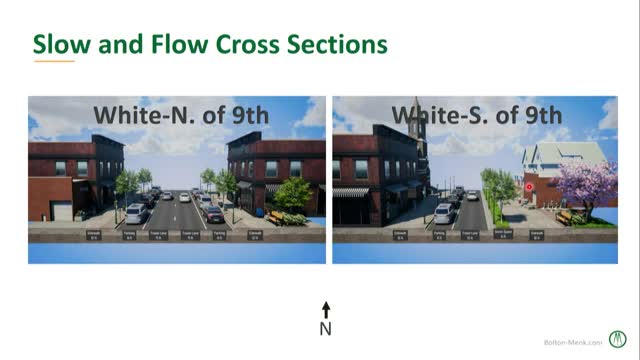City plans transformative changes for safer multimodal corridor
September 30, 2024 | Dubuque City, Dubuque County, Iowa
This article was created by AI summarizing key points discussed. AI makes mistakes, so for full details and context, please refer to the video of the full meeting. Please report any errors so we can fix them. Report an error »

During a recent government meeting, officials discussed potential changes to a key transportation corridor, focusing on enhancing safety, economic development, equity, and connectivity. The conversation centered around the configuration of streets, particularly the possibility of implementing a two-way street system north of 13th Street, while maintaining the existing one-way system south of it.
Jennifer, a city planner, highlighted the importance of creating amenity zones, such as transit shelters, to improve the walking experience along the corridor. She noted that survey data indicated a preference for two-way streets in certain areas, which could facilitate better circulation for both commercial and residential traffic.
Andrew, another city official, presented an evaluation matrix that assessed four proposed alternatives against the guiding principles of safety, economic development, equity, and connectivity. He emphasized that the success of the corridor's redesign hinges on achieving these principles, warning that without them, the area risks remaining a traditional highway corridor.
The evaluation matrix categorized the alternatives using a color-coded system: red indicated negative effects, yellow represented neutral impacts, and green signified positive outcomes. Andrew explained that while a high number of conflict points were noted in some scenarios, the actual number of crashes remained low, suggesting that slower speeds in the area contributed to heightened driver awareness and safety.
A significant point of discussion was the potential addition of a cycle track, which could be integrated into any of the proposed alternatives. However, this would necessitate the removal of parking on one side of the street, highlighting the trade-offs involved in the planning process.
The meeting concluded with an invitation for further questions and community input, as officials seek to balance the diverse needs of the corridor's users while promoting a safer and more accessible environment.
Jennifer, a city planner, highlighted the importance of creating amenity zones, such as transit shelters, to improve the walking experience along the corridor. She noted that survey data indicated a preference for two-way streets in certain areas, which could facilitate better circulation for both commercial and residential traffic.
Andrew, another city official, presented an evaluation matrix that assessed four proposed alternatives against the guiding principles of safety, economic development, equity, and connectivity. He emphasized that the success of the corridor's redesign hinges on achieving these principles, warning that without them, the area risks remaining a traditional highway corridor.
The evaluation matrix categorized the alternatives using a color-coded system: red indicated negative effects, yellow represented neutral impacts, and green signified positive outcomes. Andrew explained that while a high number of conflict points were noted in some scenarios, the actual number of crashes remained low, suggesting that slower speeds in the area contributed to heightened driver awareness and safety.
A significant point of discussion was the potential addition of a cycle track, which could be integrated into any of the proposed alternatives. However, this would necessitate the removal of parking on one side of the street, highlighting the trade-offs involved in the planning process.
The meeting concluded with an invitation for further questions and community input, as officials seek to balance the diverse needs of the corridor's users while promoting a safer and more accessible environment.
View full meeting
This article is based on a recent meeting—watch the full video and explore the complete transcript for deeper insights into the discussion.
View full meeting
